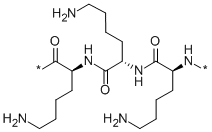

IdentificationPhysical DataSpectraRoute of Synthesis (ROS)Safety and HazardsOther Data
Identification
Product NamePOLYLYSINEIUPAC Name(2S)-2,6-diaminohexanoic acidMolecular StructureCAS Registry Number 25104-18-1EINECS Number213-091-9MDL NumberMFCD02668012Beilstein Registry Number1722530SynonymsL-lysinelysine56-87-1h-Lys-oh(S)-LysineAminutrinalpha-LysineLisinaLysinumLysinum lysinLYS (IUPAC abbreviation)lysCHEBI:18019lysina(+)-S-LysineBRN 1722531HSDB 2108AI3-26523EINECS 200-294-2UNII-K3Z4F929H6DTXSID6023232K3Z4F929H6DTXCID403232Lysinum (Latin)4-04-00-02717 (Beilstein Handbook Reference)LYSINE (II)LYSINE LYSINE (MART.)LYSINE B05XB03200-294-2lysine acid(2S)-2,6-diaminohexanoic acid(S)-2,6-Diaminocaproic acidL-(+)-Lysine(S)-2,6-Diaminohexanoic acidHydrolysin25104-18-1L-lysLisina L-Norleucine, 6-amino-Lysine, L-(S)-alpha,epsilon-Diaminocaproic acidLysine L-2,6-Diaminocaproic acidHexanoic acid, 2,6-diamino-, (S)-a-Lysine2,6-Diaminohexanoic acid, (S)-L-Lysin12798-06-06-ammonio-L-norleucineMFCD00064433L-LYSINE, MONOACETATE3H-Lysine2,6-diaminohexanoateL-Lysine, labeled with tritiumL-aLysine.alpha.-LysineLysine homopolymer1ozv1yxd3h-l-lysine6-amino-AminutrinNCGC00164527-01L-?LysineH-Lys(-)-lysineL-Lysine (Standard)6-amino-L-NorleucineLysine (USAN/INN)L-2,6-DiainohexanoateL-2,6-DiaminocaproateLYSINE LYSINE LYSINE LYSINE L-LYSINE LYSINE (S)-a,e-Diaminocaproateepsilon-Lysine homopolymerLYSINE L-Lysine, >=97%bmse000043bmse000914Epitope ID:136017(S)-2,6-DiaminohexanoateL-2,6-Diainohexanoic acidCHEMBL8085GTPL724(S)-2,6-diamino-Hexanoate(S)-a,e-Diaminocaproic acidL-Lysine, analytical standardL-Lysine, >=98%, FGHY-N0469R(S)-2,6-diamino-Hexanoic acidL-Lysine, >=98% (TLC)BDBM217367(2S)-2,6-Diamino-hexanoic acidHY-N0469L-H2N(CH2)4CH(NH2)COOHTox21_112158s5630.alpha.,.epsilon.-Diaminocaproic acidAKOS006239081AKOS015855172CCG-266180CS-W019758DB00123FL15266CAS-56-87-1NCGC00166296-0220166-34-1AC-14492AS-11733DA-54968FL165793TYROSINE IMPURITY B (S)-.alpha.,.epsilon.-Diaminocaproic acidL-Lysine, crystallized, >=98.0% (NT)L0129L-Lysine, Vetec(TM) reagent grade, >=98%C00047D02304G72513SBI-0633577.0002A919375(S)-2,6-Diaminocaproic acid;(S)-(+)-Lysine;LysineBRD-K86016185-001-01-3Q20816880F0001-14720013CD6B-1671-4369-B1BE-F531611E50C7Molecular FormulaC6H14N2O2 Molecular Weight146.19InChIInChI=1S/C6H14N2O2/c7-4-2-1-3-5(8)6(9)10/h5H,1-4,7-8H2,(H,9,10)/t5-/m0/s1InChI KeyKDXKERNSBIXSRK-YFKPBYRVSA-NSMILESC(CCN)C(C(=O)O)N
Patent InformationPatent IDTitlePublication DateWO2023/60310A SPERM EXTENDER MEDIUM2023WO2023/168053HPDL INHIBITORS AND USES THEREOF2023US2023/210110METHOD FOR INDUCING ENVIRONMENTAL STRESS TOLERANCE IN PLANTS2023US2023/210110METHOD FOR INDUCING ENVIRONMENTAL STRESS TOLERANCE IN PLANTS2023US2023/210110METHOD FOR INDUCING ENVIRONMENTAL STRESS TOLERANCE IN PLANTS2023CN115260068Divalent metal co-salt compound taking methionine hydroxyl as tablet base as well as preparation method and application of divalent metal co-salt compound2022WO2020/180941PHARMACEUTICAL COMPOSITIONS CONTAINING FREE BASES AND METHODS OF USE THEREOF2020CN109678715Salts prepared from 2-(1-acyloxy-n-amyl)benzoic acid and basic amino acid or aminoguanidine, and preparation method and application thereof2019
Physical Data
AppearanceWhite powder
Melting Point, °C Comment (Melting Point)215215224 - 225196225229.3Decomposition, Crystallization with 1 Mol(s) H2O187 - 189
Description (Association (MCS))Solvent (Association (MCS))Temperature (Association (MCS)), °CPartner (Association (MCS))Desorption159H-ZSM-5 zeoliteSorption tablewaterzeolite LAdsorption isothermwater25zeolite LFurther physical properties of the adsorbed moleculezeolite LRate of adsorptionwaterzeolite LFurther physical properties of the adsorbed moleculeP-25Further physical properties of the adsorbed moleculetitanium(IV) oxide
Spectra
Description (NMR Spectroscopy)Nucleus (NMR Spectroscopy)Solvents (NMR Spectroscopy)Temperature (NMR Spectroscopy), °C Frequency (NMR Spectroscopy), MHzChemical shifts1HChemical shifts1Hwater-d224.84500.1Chemical shifts1Hwater-d2600Spectrum1Hwater-d2, aq. phosphate buffer22.84Chemical shifts1HHSQC (Heteronuclear Single Quantum Coherence), Spectrum1H, 13CHMBC (Heteronuclear Multiple Bond Coherence), Spectrum1H, 13C
Description (IR Spectroscopy)Solvent (IR Spectroscopy)SpectrumSpectrumpotassium bromideBands, Spectrumpotassium bromideBands, SpectrumBands, SpectrumATR (attenuated total reflectance), Bands, SpectrumATR (attenuated total reflectance), Spectrum
Description (UV/VIS Spectroscopy)Solvent (UV/VIS Spectroscopy)Absorption Maxima (UV/VIS), nmSpectrumSpectrumwaterSpectrumSpectrumwaterSpectrumwaterSpectrumneat (no solvent, solid phase)
Route of Synthesis (ROS)
Route of Synthesis (ROS) of Polylysine CAS 25104-18-1
ConditionsYieldWith sodium hydroxide In 1,4-dioxane; water at 20℃; for 1h; pH=10 - 11;Experimental ProcedureThis synthesis is in accordance with Galbiati, B.; Ferrario, T.; Merli, V. WP 0110851(2001). A 250 mL three-necked flask was loaded consecutively with water (20 mL), 1,4-dioxane (20 mL) and L-lysine (2.1 g, 14.4 mmol). The mixture was stirred until complete dissolution. The pH was adjusted to about 10.5 by addition of 30% NaOH. Benzylchloroformate (5.2 g, 30.6 mmol) was added while maintaining the pH at about 1011 by adding at the same time 30% NaOH. At the end of the addition, the reaction was stirred at 20° C. for about 1 hour. The pH was adjusted to 5 with 37% HCl. Ethyl acetate (30 mL) was added and the pH was adjusted to 1 with 37% HCl. The mixture was stirred at room temperature for about 30 minutes, the organic layer was separated and the aqueous layer was extracted with ethyl acetate (20 mL). The combined organic layer was washed with brine (30 mL), and dried over Na2SO4. Then, the solvent was evaporated to yield a yellowish oil (6.0 g, 99%). The oil was pre-dried by azeotropic distillation with benzene.99%With sodium carbonate In diethyl ether; water at 0℃; for 5h;Experimental Procedure1.1 Step 1,1. 155 mol of Cbz-Cl was dissolved in 100 mL of diethyl ether solution,200 mL of a 10% NaCO3 aqueous solution containing 0.0645 mol of L-lysine was added dropwise,After the addition was completed, the reaction was maintained at 0 ° C for 5 hours, and the product was obtained with an appropriate amount of 10% lemonAcidified and extracted with chloroform,The reaction layer was washed with water to give a large amount of waterN, N'-bis-benzyloxycarbonyl-L-lysine,The yield is about 95%.95%With sodium carbonate In diethyl ether; water at 0℃; for 5h;Experimental Procedure1.1 Step 1Step 1, 0.322 mol of Cbz-Cl was dissolved in 100 mL of diethyl ether solution,200 mL of a 10% NaCO3 aqueous solution containing 0.055 mol of L-lysine was added dropwise,After the dropwise addition to maintain the temperature 0 reaction 5h,The resulting product was acidified with an appropriate amount of 10% citric acid and extracted with trichloromethane.The product was washed with water and evaporated to give a large amount of N, N'-bis-benzyloxycarbonyl-L-lysine,The yield is about 93%.93%
Safety and Hazards
GHS Hazard StatementsNot Classified
Source: European Chemicals Agency (ECHA)License Note: Use of the information, documents and data from the ECHA website is subject to the terms and conditions of this Legal Notice, and subject to other binding limitations provided for under applicable law, the information, documents and data made available on the ECHA website may be reproduced, distributed and/or used, totally or in part, for non-commercial purposes provided that ECHA is acknowledged as the source: “Source: European Chemicals Agency, http://echa.europa.eu/”. Such acknowledgement must be included in each copy of the material. ECHA permits and encourages organisations and individuals to create links to the ECHA website under the following cumulative conditions: Links can only be made to webpages that provide a link to the Legal Notice page.License URL: https://echa.europa.eu/web/guest/legal-noticeRecord Name: (1-Cyano-2-ethoxy-2-oxoethylidenaminooxy)dimethylamino-morpholino-carbenium hexafluorophosphateURL: https://echa.europa.eu/information-on-chemicals/cl-inventory-database/-/discli/details/213446Description: The information provided here is aggregated from the “Notified classification and labelling” from ECHA’s C&L Inventory. Read more: https://echa.europa.eu/information-on-chemicals/cl-inventory-database
Other Data
TransportationClasUnder the room temperature and away from lightHS CodeStorageUnder the room temperature and away from lightShelf Life2 years
DruglikenessLipinski rules componentMolecular Weight146.189logP-2.896HBA3HBD2Matching Lipinski Rules4Veber rules componentPolar Surface Area (PSA)93.79Rotatable Bond (RotB)5Matching Veber Rules2
Use PatternOften used as a preservative in food, medicine, cosmetics, etc. https://www.chemwhat.com/polylysine-cas-25104-18-1/
Comments
Post a Comment